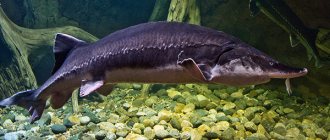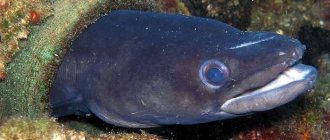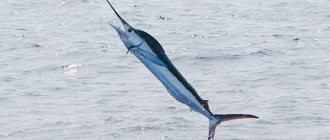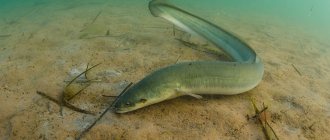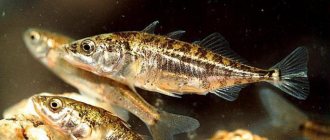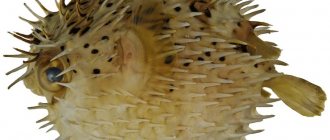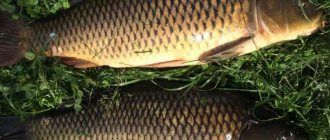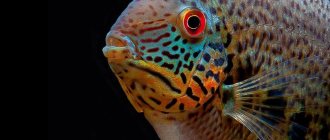Origin of the species
Marlin is a large fish that lives in the Atlantic Ocean.
Billfish belong to the family of ray-finned fish. The scientific classification of the species is as follows:
- Domain: eukaryotes.
- Kingdom - animals (bilaterally symmetrical).
- Phylum: chordates (deuterostomes).
- Class - ray-finned (bony fish).
- Series - percomorphs.
- The order is mackerel-shaped.
- Suborder - mackerel-like.
Marlin is a mackerel-like fish species.
The ancestor of marlins is the predatory fish Andreolepis hedei (a species of paleonisciformes). About 200 million years ago, during evolution, the family was divided into 2 subclasses - cartilaginous and newfeathered.
The first description of the species belongs to the French ichthyologist Bernard Lacepède. However, there are versions according to which English navigators Richard Chancellor and Hugh Willoughby observed marlin in the Atlantic Ocean during a trading expedition. The oldest find of a large fish is 23 million years old.
Taxonomy[edit | edit code]
The species was first described in 1802 by the French ichthyologist Bernard Lacepede based on a drawing. The holotype is missing. Subsequently, various generic and species names were repeatedly assigned. Makaira nigricans is recognized as valid
[6].
Makaira nigricans debated
and
Makaira mazara
, as separate species. Genetic evidence suggests that although these species are geographically separate, they may be a single species[7][8].
The generic name comes from the Greek. μαχαίρα - “short dagger” and lat. machaera - “dagger”, while species - from lat. nigricans - “becoming black.”
Description of marlin fish and main features
The generic name is Macaira nigricans (translated from Greek as “short dagger”). The name “marlin” is due to the similarity of the spear-shaped snout with a rigging tool (marlinspike). The features of the fish, in addition to its appearance, include:
- The speed of movement of an adult is up to 110 km/h.
- Oxygen is obtained by passing water through the fins. Marlin fish are always on the move, even while sleeping.
- The ability to change the color of the body if necessary.
- The largest individual had a length of more than 5 m and a weight of over 700 kg (according to the IGFA organization).
Appearance
Female marlin fish have a larger body size compared to males (the length of the body can be 2 times greater). The average weight of males is 150-170 kg, females - 480-600 kg. Marlin moves using 4 fins - 2 dorsal and 2 anal. The body of the fish is dark blue with silver stripes on the sides.
The body of a marlin fish.
Among other features of the fish, it is important to note the following points:
- the length of the spear-shaped snout of the marlin is about 20% of the total length of the body (in males - 30-40 cm, in females - up to 1 m);
- the body of the fish is covered with elongated scales, in the center of which there is one or more pigment points;
- the palatine bones and jaws of the marlin are covered with small teeth;
- The fish's eyes are the size of a human fist in large specimens.
Character
To move, marlins use mainly surface layers of water, away from the coastline. Some fish from the billfish family undergo seasonal migrations; the length of the journey can be more than 7,000 miles.
According to ichthyologists, the behavior of the animal has many similarities with sharks - they are not afraid of people (although they do not strive to make contact), they are well trained, and quickly react to noise and artificial bait. There is a social hierarchy within a species.
Differences from swordfish
The main difference lies in the shape of the elongated upper jaw; The marlin has a rounded spear-shaped snout, while the swordfish has a flattened snout, similar to a pointed sword or knife with a wide blade. The body of an adult swordfish is smooth, without scales or bumpy growths. Adult representatives of this species do not have teeth. The color of a large swordfish is silvery-white, sometimes with blue stripes.
Swordfish, unlike marlin, have a smooth body and an elongated upper jaw.
Description
Marlins belong to the sailfish family of the mackerel order of the ray-finned fish class.
In 1802, Bernard Lacepède, a scientist specializing in the study of fish, used the image to make the first description of the marlin fish as a separate species; it was officially given a scientific name that had nothing to do with the existing one.
The fish got its nickname, which later became the generally accepted name, marlin from the tool used by sailors in working with ropes - the “marlinstein”. Also, some Russian fishermen call it “merlin”. The instrument has an elongated shape with a pointed end. Later, the data given by Laceped was repeatedly corrected and supplemented with new ones, in terms of structural features, anatomy, and lifestyle.
Marlin or merlin is the largest of the bony fish (some individuals grow over five meters in length). It has a streamlined, elongated body, tapering towards the tail, with two dorsal fins, where the large one extends across the entire body. The enormous speed of the marlin allows it to develop a spear-shaped appendage; in this case, the fins work as stabilizers of a stable position. It is included in the ranking of the fastest fish. The jaw bones have small teeth.
The body of the fish is covered with hard scales. The lateral lines of parsunidae have increased sensitivity and are able to detect the slightest fluctuations in the water space, which makes it possible not only to orientate well in the water column, but also to detect potential prey at a distance.
Marlin is an active fish, its activity is associated with the need to obtain oxygen by passing water through its fins.
All members of the swallowtail family are extremely prolific. They spawn from August to September in near-equatorial waters and the tropics. One female is capable of laying up to five million eggs at a time. Most of the eggs die, becoming food for other fish, the remaining part develops independently.
During the larval stage of development, marlin grows very quickly - within 24 hours the fry grows by 16 mm.
Fish of this family have practically no enemies except several species of sharks.
The lifespan of male marlins is no more than 18 years, but females live much longer - 25 years or more.
Main varieties
There are dozens of billfish species, of which 7 are the most common. Moreover, some species have several names depending on their habitat (Western Atlantic spearfish, North African marlin).
Black
The Latin name of the species is Istiompax Indica. The largest of all marlin species. The average length of a highly elongated body, compressed from the sides, is 4.5 m. External characteristics include:
- dark blue or black color of the body, with a purple tint;
- wide fins located on the side of the back;
- the caudal fin is crescent-shaped, reaching a size of up to 70 cm between the outer lobes.
The annual catch does not exceed 6 thousand tons. Fish meat is considered a delicacy. Another common purpose of fishing is to satisfy the sporting interest of fishermen and sailing trolling enthusiasts.
Black Marlin - Istiompax Indica.
Striped
Marlin belongs to the genus Kajikia audax. The size of the individual is smaller than all other varieties of marlin. Males are larger than females, their average weight varies between 120-150 kg, and their body length is up to 2 m. A distinctive feature of striped marlins are transverse blue stripes on the body. The fish's fins have rainbow spots.
Striped marlin - Kajikia audax.
Blue or Atlantic blue
According to scientific classification - Makaira nigricans. The heat-loving inhabitant of the Atlantic Ocean has a white belly, which sharply contrasts with the dark back. During the hunt, the body of the fish acquires a light blue color. The dorsal and anal fins of marlin can be retracted arbitrarily into grooves located on the sides (to reduce water resistance when swimming). Individuals reach speeds of up to 100 km/h.
Blue (Atlantic) marlin - Makaira nigricans.
White
Features of the Atlantic white spearfish (Kajikia albida) include light coloration of the body, pointed scales and relatively small size (up to 2 m in length and weighing no more than 100 kg). The caudal fin is slightly compressed laterally; There are white spots along the surface of the fish’s body, and less often, light silvery stripes.
White marlin - Kajikia albida.
Mediterranean spearman
Latin name: Tetrapturus belone. The body, elongated in the shape of a torpedo, does not exceed 2 m in length; the maximum weight that was recorded was 70 kg. The length of the nose spear is small in comparison with other varieties of billfish (20-40 cm). The head profile of the fish is slightly curved.
Mediterranean marlin - Tetrapturus belone.
The body color and appearance of the spearfish is similar to a swordfish (except for the shape of the snout).
Short-snouted spearman
The spearfish (Tetrapturus angustirostris) is the smallest member of the billfish family. The appearance parameters of a spearman include the following items:
- The body length is about 1.3 m (the largest representative is 2.3 m).
- Weight - 50 kg.
- A short snout with a spear length of 20-30 cm.
- Large caudal fin with sharp division into blades.
- The color of the spearman's body is light blue, silver or brown. There are white stripes on the sides and belly.
Short-snouted spearfish - Tetrapturus angustirostris.
Small Spearman
It was isolated as a separate species in 1963. The name in the scientific classification is Tetrapturus pfluegeri. Thanks to their strongly laterally flattened body, individual individuals are capable of reaching speeds of up to 110 km/h. With a long body reaching 2.5 m, the mass of an adult is small - 55-70 kg. The small spearfish often lives in coastal areas, which distinguishes it from other representatives of billfish.
Lesser spearfish - Tetrapturus pfluegeri.
Kinds
There are seven known species of marlin. Let's look at each of them in more detail.
Atlantic blue marlin
The most common type. One of its features is the high, sail-like fin on its back. The body of Makaira nigricans has a round cross-section. A resident of not only the Atlantic Ocean, but also the Pacific. those that live in the Pacific Ocean are usually slightly larger. The length is about five meters. This species has a pair of anal fins and the same number of dorsal fins. They are supported by bone rays. In the first dorsal fin there can be up to 43 of them, in the second - six or seven.
The first anal fin is similar to the second dorsal fin. It can have up to 16 rays. The ventral fins are sharp and narrow. They can fold into a small depression on the body. This allows the marlin to develop greater speed when necessary. The size of the spear is 2/10 of the length of the entire body. It is capable of migrating quite far, but during cold periods of the year it prefers to live near the equator.
Black Marlin
Most often lives in coastal areas and tropical climates. It settles at a depth of no more than 200 meters, preferring coral reefs. The largest specimen caught weighed about 700 kg, weighing on average 150-140 kg. The pectoral fins are placed perpendicularly; it does not know how to fold them. The back is deep black and has a metallic purple sheen. The main diet is mackerel, herring and tuna. The body is not too compressed, but elongated; the caudal fin is shaped like a moon. Like blue marlin, it is interesting for fishing for sporting purposes and for industry.
Striped marlin
Can also be called a striped spearman. Its maximum size is slightly smaller than that of other marlins. The body length is 4.2 meters, weight - up to 190 kg.
The body of this marlin is slightly flattened on the sides. There are grooves on the ventral and pectoral fins; marlin can fold them during an attack. The maximum speed is 75 km/h. It is distinguished by a dark blue back and silvery, bluish-tinged sides. The entire body is covered with numerous blue stripes, which is why the marlin got its name. The fins are covered with rainbow spots.
Lives in the upper layers of water. They hunt either in splendid isolation or in packs of up to a dozen individuals. Prey: schooling sea fish with squid and other inhabitants of the Indian and Pacific oceans.
Mediterranean spearman
Also known as Mediterranean marlin. It lives, as the name implies, in the upper layers of the sea of the same name, away from its shores. Rarely has a mass of more than 70 kilograms and reaches a length of more than two and a half meters.
Known for its interestingly curved head profile. The body of the spearman is torpedo-shaped; there are two longitudinal keels on the caudal peduncle. The first dorsal fin has up to 46 rays, they are soft. The second fin is smaller and has only seven rays. The belly is whitish, the sides are slightly lighter than the back. It is a powerful and fast swimmer, actively hunting schooling fish.
White Marlin
Also called the white Atlantic spearman. It lives in the Atlantic, most often in the Caribbean Sea. It differs from its species in that it does not like great depths and can live near the shore. Externally, the white marlin is very similar to the striped one, but is known for its fins with dark spots, as well as its back with a greenish tint. In addition, its pectoral fins are more round.
White marlin reaches a maximum length of three meters. It feeds on small tunas, mackerel tunas, squids and also seleniums.
Short-winged Spearman
Not one of the larger marlin species. It is up to 190 cm long and weighs up to 52 kilograms. Most often, the short-winged spearfish is found in the Indian Ocean. Loves the southern islands of Japan, the waters of Taiwan, New Zealand and Hawaii. Also found in the eastern Pacific regions, such as near Peru and California. The body is slightly compressed laterally and elongated. The spear-shaped appendage is slightly shorter than that of other marlins. The scales are also different. Thus, in the short-winged spearman it is jagged along the edges.
Small Spearman
Also called Western Atlantic. Habitat - Atlantic, more precisely, its subtropical regions. The length of the body reaches 2.5 meters, weight – up to 58 kg. It is known for its rather powerful elongated body, which is strongly flattened on the sides. The larger dorsal fin has up to five dozen rays. It has a dark, slightly blue-tinged back and silvery sides. The scales are pointed and unusual in shape.
Lifestyle and its duration
The marlin family belongs to predators that lead a solitary lifestyle (that is, they do not gather in schools). The exception is the short-snouted spearfish - these marine inhabitants hunt together, pursuing small fish together. Such groups can include up to 10-12 adults. The main activity occurs in the summer months; During this period the greatest number of marlin are caught. Hunting takes place during the daytime. The average lifespan of fish is 23 years (16-18 years for males, 24-28 for females).
Description[edit | edit code]
Complete blue marlin skeleton at the North Carolina Museum of Natural History
The maximum size of females is four times that of males. Males rarely reach a weight of 160 kg, while females usually weigh more than 540 kg.[9]
The body length of females together with the “spear” reaches 5 m, the distance from the eyes to the end of the spear is 20% of the total length. The maximum body weight of females is from 540 to 820 kg, depending on the source of information (not all specimens have been reliably measured)[10]. The official scientifically recorded record weight is 636 kg[11].
Blue marlin have two dorsal and two anal fins. The fins are supported by bony rays. The first dorsal fin has from 39 to 43 rays[12]. The second dorsal fin has 6-7 rays. The first anal fin, which is similar in shape and size to the second dorsal fin, has 13-16 rays, and the second anal fin has 6-7 rays. Long and narrow pelvic fins with 19-22 rays can be retracted into a special recess in the side. The pectoral fins are shorter than the pelvic fins, have a poorly developed membrane and are recessed into the ventral groove. The first anal fin, together with the ventral and pectoral fins, can be retracted into a groove. Due to this, resistance when swimming is reduced. The body is dark blue above and silvery on the sides. The body has approximately 15 rows of pale greenish-blue stripes, each with round dots and/or thin stripes located on both sides of the body.[12]
The membrane of the first dorsal fin is dark blue or almost black and has no spots or markings. The other fins are usually dark brown, sometimes with a dark blue tint. The base of the first and second anal fins are silvery. Marlin can change color quickly and usually turn bright blue when hunting. Color change occurs with the help of iridophores containing pigments and reflective cells[13].
The body is covered with thin elongated scales, in the back of the scales there is usually one, and sometimes two or three points.
The spear is long and strong. Both jaws and palatal bones are covered with small, file-like teeth. The lateral line contains neuromasts located in the canal. These cells detect subtle movements of water and large changes in pressure[14]. Clearly expressed in juveniles, but unclear in adults; as the fish grow, it becomes more and more embedded in the skin[12].
The anal opening is located immediately behind the beginning of the first anal fin. The blue marlin, like all members of the billfish family, has 24 vertebrae[15].
Habitats
The fish is found primarily in the Atlantic Ocean. Preference is given to waters with temperatures of +24 ° C and above, however, some representatives have been spotted in the eastern part of the Atlantic, where the average water temperature is +21 ° C. The distribution range of marlin and spearfish includes the following places (depending on the species):
- Waters of the Red, Mediterranean and Black Seas.
- Coastal waters of the Indian and Pacific oceans.
- Deep waters of the Coral and East China Seas.
During the warmer months, the fish's range may expand; At the same time, the migration period begins. Their route could take them between Venezuela and the Caribbean islands, or between West Africa and the Virgin Islands. Migrations of individuals can be both repeated (with a return to their previous places) and final.
The coastal waters of the Indian Ocean are one of the habitats of marlin.
How to smoke marlin
Smoking fish involves following a certain sequence and following the rules. Otherwise, the delicacy will not turn out as tasty as expected. You can prepare smoked meats in several ways, each of which has its own characteristics.
Classic cold method
Like other valuable, expensive fish, it is better to smoke marlin using a cold method. Cooking according to a simple recipe involves using the following ingredients:
- 2500 grams fish fillet
- 100 grams of salt;
- 60 grams of sugar;
- 2 tablespoons black pepper;
- half a tablespoon of cayenne pepper;
- tablespoon white pepper.
The preparation procedure consists of the following steps:
- Combining all the dry ingredients and then rubbing the fish fillet with this mixture.
- Marinate in the cold for more than 12 hours.
- Rinse the fish under running water and dry it with paper towels.
- Laying the marlin on the grill in the smoking unit.
- Putting wood chips into a smoke generator.
- Connect the compressor and select a temperature of 45 degrees. After this they smoke for 60 minutes. In this case, it is worth making sure that the air dampers are open.
- The dampers are closed and a container of water is installed in the unit.
- The temperature is increased to 65 degrees and the delicacy is prepared for another 4 hours.
- The fish is cooled and ventilated in fresh air for 10 hours.
Diet
The food for marlin larvae is zooplankton, detritus, planktonic eggs and embryos of small animals. Adults lead a predatory lifestyle, hunting large and medium-sized fish. Their diet includes:
- tuna;
- mackerel;
- Mackerelites;
- sea breams;
- squid;
- longfins;
- shrimps;
- swimming crabs;
- cephalopods;
- glowing anchovies.
Shrimp is one of the food sources for marlin fish.
Large billfish species (particularly black marlin) may prey on swordfish or spearfish. The animal catches prey with the help of a spear-shaped head - accelerating, they crash into a school of fish at high speed, trying to pierce or stun the victim.
Character and lifestyle
Interesting. During the hunt, this sea resident uses a rather unusual tactic - she swims back and picks up strong speed. After which, at full speed, it crashes into schools of swimming fish. Thus, it stuns its victims or pierces them through.
This fish has a very interesting anatomical feature. There are special pigment cells in her body. Thanks to them, the merlin can change the color of its body during the hunt. This makes them virtually invisible to prey.
In 24 hours, a representative of the marine fauna is able to cover a distance of up to 70 kilometers. Seasonal migrations over distances of up to 8 thousand miles are often observed.
Features of reproduction
Sexual maturity occurs in marlin fish at 2-4 years of age. Females mature at a weight of 47-61 kg, males at 36-44 kg. Spawning occurs once a year, from May to August (however, for spearmen, the breeding season can last until November). The location of the spawning area depends on the variety of marlin fish; most often it is located in near-equatorial waters with weak currents and a gravel bottom. Interesting features of the mating season include the following facts:
- The high growth rate of fish larvae is about 15-16 mm per day.
- The preferred water temperature for marlin spawning is +28 °C.
- Female marlin spawn up to 4 times in one season. The fertility of individuals reaches over 6 million larvae, most of which die at the earliest stage of development from other predators.
- The diameter of the eggs is 1 mm.
- After laying fish eggs, individuals do not show any care towards their offspring.
Reproduction and offspring
The minnows, representing the northern and southern hemispheres, mature on similar calendar dates, indicating the homogeneity of this marlin species. Females of this species spawn only once during the year.
Black marlin go to spawn in conditions when the water temperature reaches +28 degrees, while the spawning period depends on the climatic conditions of the entire region. Representatives of the waters of the South China Sea go to spawn in late spring or early summer, and within the territorial waters of Taiwan this process begins in August and ends in September. The northwestern waters of the Coral Sea are characterized by the fact that marlin spawn here from the beginning to the end of autumn. The female lays eggs in stages, and she is capable of laying up to 40 million eggs.
Sailfish spawn in late summer or early autumn in warm near-equatorial or tropical waters. Individuals do not show any concern for their future offspring, especially since sailfish have pelagic eggs that drift in the water column under the influence of the current. All types of sailboats are also highly fertile. During the spawning process, the female lays, in general, up to 5 million eggs, in several stages.
It is important to know! After birth, marlin fry develop quite quickly and under favorable conditions, their growth is up to 15 mm per day.
Most marlin offspring die at the caviar stage, as well as at the fry stage. And this is not surprising, since eggs and fry are eaten by many species of predatory fish in the world's oceans.
Natural enemies
Large individuals (black and blue marlin) have no natural enemies, with the exception of mackerel and white sharks. Swordfish, killer whales and golden mackerel may pose greater threats to shortwing spearfish. For larvae and juveniles, the danger comes from most pelagic fish - tuna, herring, manta rays, pilotfish, remoras, etc.
The killer whale is a natural enemy of the short-winged spearfish.
Population and species status
All representatives of billfish are valuable commercial species. Frequently visited fishing spots include Cape Runway and Waihau Bay. Due to its unusual appearance and relative rarity, the fish is a prestigious object for sport fishing. According to ichthyologists, since 2000 the population of these animals has been declining due to overfishing.
In 2010, black and blue marlin were classified as Vulnerable, and the environmental organization Greenpeace added the large fish to its red list of species at high risk of extinction due to human activities.
Varieties and their differences
Like all fish, marlin has its own varieties, slightly different in the shape of the fin and the shade of the scales. Their hunting principles and lifestyle are similar, all species are also edible, and their meat is in special demand in restaurants in many countries .
- Black marlin is the giant of the family. The fins of the black type lack flexibility, the first dorsal fin is long with sharp rays, the second is located lower and smaller in size. The tail is sickle-shaped, with thin blades. The color is dark blue, closer to black, the belly is silver. The size of the giant allows it to descend to a depth of up to two kilometers with a temperature of 15 degrees.
- Striped marlin differs from its relatives not only in its specific color, but also in the size of its nose. A medium-sized fish reaches a mass of 500 kg, has fixed fins and a more varied color: the back is blue, streaked with light transverse lines, and they are blue on the silver belly.
- Blue marlin, or blue marlin, has the ability to change hue when hunting. The back is dark blue with characteristic stripes, the belly is silver, the fins are dark, high, flexible, tucked into a special compartment on the back.
All species are real racers; thanks to their specific body structure, they quickly pick up speed and maneuver easily; their type of swimming is similar to that of a shark.
Features of fishing
Marlins are passionate in their hunting - even when they are full, they attack the bait. The main requirement for successful fishing is the placement of the bait at the desired water depth: about 40-50 m for a large representative and 20-30 m for a spearfish or a small specimen.
Right time and place
The best period for fishing is the beginning of the migration season, which occurs in May or June. Experienced fishermen give the following advice:
- the activity time of individuals is 11-13 hours of the day, when the sun is at its zenith;
- the weather should not be cloudy or cloudy, because... in this case, fish rarely leave the depths of the sea;
- it is necessary to look for places far removed from the route of movement of large merchant ships.
Marlin fishing is done with bait.
Tackle
Large marine predators require the use of especially strong gear that can withstand heavy loads. These include trigger-type sea fishing rods. They have the following properties:
- Breaking load - over 60 kg.
- The presence of a high-power multiplier reel with a spool capacity of 1.5 km of cord (section 4 mm).
- Average length - from 4 m.
- Weight - from 400 to 600 g.
- Reinforced pass rings.
- The connection of the elbows is plug-in, telescopic or solid.
Lures
Natural baits include most mackerel-like fish (saury, anchovy, sardinella, flying fish, gempil). Among artificial baits for marlin, deep-water wobblers are especially effective - a hard-bodied bait for deep-sea fishing.
Due to its design, the wobbler imitates the movements of a wounded or sick fish, which attracts potential predators. It is acceptable to use other animal simulators - octopuses, sinkers, plankers and jig baits.
Basic methods of catching
A common method of recreational marlin fishing is trolling (throwing gear from a slow-moving vessel, which imitates the natural movement of prey in the sea). At the same time, such fishing requires significant financial costs - in addition to a specialized yacht, it is necessary to have strong rod holders, reels, powerful echo sounders and other auxiliary devices.
Trolling is the main form of marlin fishing.
Budget options for catching marlin are possible - using a harpoon and bait gear. However, these methods are rarely used, because They are designed for fish that live in surface waters at shallow depths.
Fishing
The final stage of fishing, which often ends in failure for the angler. The essence of the process is to tire the fish before it is pulled on board the vessel. Given the size and temperament of the marlin, this is difficult to do. It is important to follow the following recommendations:
- Do not rush. Haste can cause the gear to break.
- When the fish jerks, use friction brakes.
- Do not pull the line with your hand, even when the marlin is almost on board.
- The gear cannot be lifted vertically - it is necessary to “drive” the fish in a circle, holding the spinning rod diagonally, with a slight tilt to the side.
Landing a giant marlin rarely takes less than a few hours. Therefore, it is important to be prepared to fight hard for the trophy. In accordance with the rules of sport fishing, the catch is counted only when, from the moment of biting, no one except the angler touches the spinning rod.
Landing is the last and most difficult stage of marlin fishing.
Habitat
The most optimal temperature for sailboats should be no lower than 23 degrees Celsius. The usual habitat is open waters, but some species feel more comfortable in coastal areas.
Marlin is a fish not used to moving in large groups, preferring to stick to small groups - no more than 10 individuals. They live in tropical latitudes, found off the coast of Ceylon and Mauritius. The usual depth for fish of this species is 50 meters, but marlin can easily make a full dive much deeper.
The basis of nutrition is large marine pelagic fish that live in the water column. There are no special preferences in food, but the most commonly consumed are tuna, squid, shrimp, anchovies and even crabs.
The conducted research helped to establish that during the full moon, the number of black marlin on the surface of the water increases, which is associated with an increase in the number of fish that it feeds on.
Although there are restrictions on the catch of marlin, this species often becomes the main trophy in sport fishing competitions. Fishing is carried out from small boats using spinning rods by pulling to the surface. The majority of marlin survive their “participation” in such events without consequences, but this is monitored by environmental organizations who record violations in photographs.
Marlin is a fish that uses unusual tactics when hunting: it accelerates and crashes into the school at great speed, piercing or stunning its prey.
Interesting fact - “Marlins, due to the presence of pigment cells, are able to change color during the hunt, which makes them less noticeable to prey.”
Marlins are able to cover a distance of up to 70 km per day. They often make seasonal migrations over impressive distances - 8,000 nautical miles or more.
Eating marlin
The meat of any representative of the marlin family is considered a delicacy. In Japan, it is used to make sushi and sashimi; in the USA, the delicacy is grilled like steak, and in Hawaii, fish cream soup is popular.
Beneficial features
Due to its low calorie content (112 kcal per 100 g), dishes from this fish can be freely consumed by overweight people. In addition, marlin meat is rich in many useful microelements:
| Minerals | Amino acids | Vitamins | Enzymes |
| Calcium | Lysine | D | Lipase |
| Phosphorus | Omega-3 fatty acids | B1 | Protease |
| Copper | Glutamine | B2 | Amylase |
| Manganese | Taurine | B5 | Pepsin |
| Iron | Alanin | B6 | Enterokinase |
| Selenium | Tryptophan | B12 | — |
| Potassium | — | H | — |
| Iodine | — | PP | — |
| Molybdenum | — | C | — |
Among the beneficial properties of marlin meat are improving brain activity and hematopoietic systems, reducing the risk of joint deformation, and strengthening the immune system. In addition, fish fillet has a sedative effect, helps calm the nervous system and promote better sleep.
Marlin fillet has many beneficial properties for the body.
Possible harm
Marlin fish contains many antigens and allergenic substances, so it is not recommended for people with hypersensitivity to seafood. Damage to health can also occur for other reasons:
- Parasites. Marlins are parasitized by over 25 species of parasites (among them are helminths, nematodes and other parasitic worms that are transmitted to humans).
- Viral infections. Lymphocytosis, papillomatosis and diseases caused by streptococci.
- High content of toxic substances (mercury, ammonia, ammonium salts) in some individuals.
Harm from consumption
There may be several reasons why marlin meat can harm the human body. Below are the main ones:
- Presence of mercury formations . Due to industrial emissions, most marine fish, including marlin, contain mercury in their bodies. And, as you know, it is a strong poison that can kill a person.
- Marlin is a strong allergen . Its individuals are strong allergens and can cause a severe allergic reaction in many people. Even with high-quality heat treatment, it is not always possible to remove all antigens from fish - substances that cause a reaction.
- Presence of toxic substances . Sea fish is at the top of the list of products containing large amounts of toxic substances. By consuming marlin meat, a person runs the risk of consuming waste from various animals and other toxic substances.
- Parasites . Everyone knows that when eating fish there is a risk of becoming infected with worms. They, in turn, will be unnoticed in the human body and awaken appetite. By consuming more food, a person will feed not only himself, but also the parasites in his body.
- Dangerous infections . Dangerous viral infections that can greatly affect human health have often been found in marlin meat.
- Possibility of poisoning . As a rule, people are poisoned by fish that has been subject to improper processing, improper storage and preparation. For example, if the specimen was stored at the wrong temperature (above minus 18) or was prepared by a cook without gloves.
Methods for preparing fish
The most common recipe is to cook marlin without heat treatment (“Hawaiian style”). To do this, you need to cut the marlin fillet into small pieces into steaks, sprinkle it with onions and peppers, then add sesame seeds, salt, soy sauce and butter to the steak. After this, the meat is placed in the refrigerator for 2-3 hours. Served as a cold appetizer or as a topping for sushi.
Large marlin fillets can be fried in a frying pan like any other fish - before doing this, the cut steaks need to be marinated and allowed to stand for 1 hour in the refrigerator.
Fish meat must be marinated in advance, and not at the time of cooking - the better the spices are absorbed, the tastier the marlin dish will be.
Fried marlin is a delicious and nutritious dish.
How to select and prepare fish
Proper selection and preparation of fish is an important stage in its preparation. Marlin can be found frozen on the counter of a fish store.
Main criteria for product selection:
- Color. Marlin meat must have a uniform color; inclusions and spots are unacceptable.
- If the product is frozen, then the amount of frost should not exceed 5 millimeters.
- The presence of ice between the carcasses indicates repeated defrosting of the product.
- The ice crust should not have any color; according to the rules, it is transparent.
- The date of manufacture and expiration date of the product should indicate the freshness of the fish.
- If E-452 is present in the product, it is recommended to refuse the purchase.
To prepare marlin for smoking, you need to perform the following manipulations:
- Defrost a carcass or piece of fillet naturally. Do not use a microwave or hot water for this.
- If you need to smoke fish without skin, you need to carefully remove it. It is also advisable to remove the fins.
- After this, you need to thoroughly clean the abdominal cavity of the fish so that no intestines remain in it.
- Rinse the carcass thoroughly and divide it into portions.
Interesting Facts
In the American writer Ernest Hemingway's story "The Old Man and the Sea", the main character unsuccessfully tries to catch a blue marlin for 3 days. The work shows well the temperament of the fish and the difficulties that fishermen face when catching it. Also interesting are the following facts:
- There is only one known case of a giant marlin attacking a person with a fatal outcome for the latter.
- The impact force of the fish's spear-shaped snout can exceed 4 tons. A large specimen can pierce a 40 cm thick board or 2.5 cm thick metal sheathing without injury.
- The maximum depth to which the fish can descend is 3 km.
Marlins often hunt large whales and sharks, but they do not eat their meat, but attack in order to drive competitors out of their territory.
Marlin fishing
Marlin is known for its excitement and attacks the bait even when it is full. The main thing is to place the bait at depths accessible to the sailboat. It rarely rises to the very surface. You need to throw the bait about 50 meters. Blue marlin rarely bite here, but striped marlin are often hooked.
The method of catching marlin is called trolling. This is towing bait on a moving vessel. It should develop decent speed. A bait sluggishly floating behind a rowing boat rarely attracts the attention of a sailfish. In addition, catching the hero of the article from a simple rook is dangerous. “Bying” their noses into massive ships, marlins pierce ordinary wooden boats right through.
Trolling is reminiscent of spinning fishing, but the gear selected is as flexible and reliable as possible. The fishing line is taken strong. All these are attributes of trophy fishing, which includes trolling.
As bait, marlin accepts live fish such as tuna and mackerel, shellfish, and turtles. Of the artificial baits, sailfish accept wobblers. It is solid and voluminous.
The bite of different types of marlin is different. Striped fish actively jump out of the water, shaking the gear in one direction or the other. The description matches the data from the story “The Old Man and the Sea.”
If the main character came across a blue sailboat, he would jerk and move jerkily. Representatives of the black species prefer to go ahead of the boat and actively, evenly pull.
Due to their size, marlins “stand” at the top of the food chain. Man is the only enemy of adult fish. However, a young sailfish is a desirable prey, for example, for sharks. There have been cases when a marlin caught on a hook was swallowed even before being pulled to the boat. When catching a sailfish, fishermen received it in the womb of a shark.
Active marlin fishing has reduced their numbers. The animal is listed in the Red Book as a vulnerable species. This limited the commercial value of sailboats. In the 21st century they are just a trophy. He is pulled up to the boat, photographed and released.

